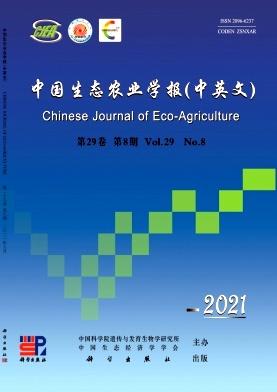Spatial variation in major water quality types and its relationships with land cover in the middle and lower reaches of Aral Sea Basin
Q3 Agricultural and Biological Sciences
引用次数: 0
Abstract
Water resources and environmental issues in the Aral Sea Basin of Central Asia are global concerns. In this study, the water quality variables (i.e., basic physical and chemical attributes, different forms of nutrients, other elements, cations, and anions) from 21 sampling sites in the middle and lower reaches of Aral Sea Basin were measured in 2019 to explore water environmental variations and their causes. Spatial variation in 20 water quality variables was investigated, and the representative water quality types, spatial differences, and their causes were identified via multivariate analysis methods (i.e., principal component analysis and cluster analysis). Furthermore, the effects of land cover on the spatial variation in water quality types were explored. The results showed that: 1) the values of electronic conductivity (EC) and total dissolved solids (TDS) increased from the middle to the lower reaches, and the highest values were in the Aral Sea. This indicates that the concentrations of anions and cations increased from the middle to the lower reaches. For the nutrient variables, high phosphorous concentrations were in the middle reaches of Amu Darya, and high nitrate-nitrogen concentrations were in the Syr Darya. For the different forms of carbon, the highest concentrations were in the Amu Darya, particularly in the delta area of lower reaches. 2) The water quality at all sampling sites can be divided into three water quality types according to the similarity classification of water quality variables. The first type had low concentrations for most water quality variables, which were distributed in the middle reaches of Syr Darya and the Aral Sea. The second type had high concentrations of different forms of nitrogen and phosphorus, which were distributed in the middle and lower reaches of Amu Darya. The third type had high concentrations of carbon, anions, and cations, which were distributed in the Aral Sea. The water quality concentrations of the first and second types were mainly due to rock weathering processes on bare land, and the anions and cations were mainly derived from the weathering of silicates and evaporites. The concentrations of the third type were mainly due to the evaporation and crystallization processes of a dry climate, and the anions and cations were mainly derived from the weathering of silicates and evaporites, which may also be affected by carbonate weathering. 3) With an increase in the buffer zone radius for each sampling point (0.5 km to 10 km), the significant land cover changed from bare land to water, shrubland, grassland, mixed farmland, and vegetation for the first water quality type; the most significant land cover was water. There were no significant relationships between the second water quality type and land cover. For the third water quality type, the significant land cover changed from water to water, mixed farmland, and vegetation - the most significant land cover was water. Therefore, spatial variation in the water quality variables was mainly affected by the local climate conditions (i.e., climatic drought and intensive evapotranspiration) and the mainland cover types (i.e., bare land, water, farmland, grassland, and urban). To improve the water environmental conditions in the middle and lower reaches of Aral Sea Basin, stream flow should be increased to recharge the Aral Sea and weaken the evaporation and crystallization processes in the lower reaches of Aral Sea. Vegetation restoration and a return of farmland to forest and grassland should also be strengthened in the riparian zone, particularly in the middle and lower reaches of Amu Darya and Syr Darya and the Aral Sea.咸海盆地中下游主要水质类型空间分异及其与土地覆被的关系
中亚咸海盆地的水资源和环境问题是全球关注的问题。本研究对2019年咸海盆地中下游21个采样点的水质变量(即基本理化属性、不同形式的营养物质、其他元素、阳离子和阴离子)进行了测量,探讨了水环境的变化及其原因。研究了20个水质变量的空间变异,通过主成分分析和聚类分析等多变量分析方法,确定了具有代表性的水质类型、空间差异及其成因。此外,还探讨了土地覆被对水质类型空间变化的影响。结果表明:1)电子电导率(EC)和总溶解固形物(TDS)由中下游逐渐增大,以咸海最高;这说明阴离子和阳离子的浓度由中游向下游递增。在养分变量上,阿姆河中游磷含量较高,锡尔河中游硝态氮含量较高。对于不同形式的碳,阿姆河的浓度最高,特别是在下游的三角洲地区。2)根据水质变量的相似性分类,将各采样点的水质分为三种水质类型。第一类水质变量浓度低,主要分布在锡尔河中游和咸海。第二类土壤中氮、磷含量较高,分布在阿姆河中下游。第三种类型碳、阴离子和阳离子浓度较高,分布在咸海。第一类和第二类水质浓度主要来源于裸地岩石风化作用,阴离子和阳离子主要来源于硅酸盐和蒸发岩的风化作用。第三类主要受干燥气候的蒸发结晶作用的影响,阴离子和阳离子主要来源于硅酸盐和蒸发岩的风化作用,也可能受碳酸盐风化作用的影响。3)随着各采样点缓冲区半径的增大(0.5 km ~ 10 km),第一类水质类型的显著土地覆被由裸地变为水域、灌丛、草地、混交田和植被;最重要的土地覆盖是水。第二类水质类型与土地覆被之间无显著相关。第三种水质类型的显著土地覆被由水变为水、混合农田和植被,其中最显著的土地覆被是水。因此,水质变量的空间变化主要受局地气候条件(即气候干旱和集约蒸散)和大陆覆被类型(即裸地、水域、农田、草地和城市)的影响。为了改善咸海盆地中下游的水环境条件,应增加径流以补充咸海,并减弱咸海下游的蒸发和结晶过程。河岸地带的植被恢复和退耕还林还草也应加强,特别是在阿姆河、锡尔河和咸海的中下游。
本文章由计算机程序翻译,如有差异,请以英文原文为准。
求助全文
约1分钟内获得全文
求助全文
来源期刊

Chinese Journal of Eco-agriculture
Environmental Science-Ecology
CiteScore
2.70
自引率
0.00%
发文量
0
 求助内容:
求助内容: 应助结果提醒方式:
应助结果提醒方式:


